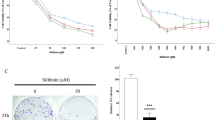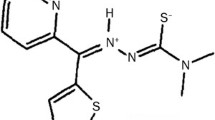Abstract
We examined the anti-tumor effect of a novel benzoic acid derivative, TAC-101 (4-[3,5-bis(trimethylsilyl) benzamide] benzoic acid) on models with liver metastasis. Oral administration of TAC-101 significantly inhibited spontaneous liver metastasis of AZ-521 (human gastric cancer ) by orthotopic implan-tation to athymic nude mice. It also inhibited both the liver metastasis of AZ-521 induced by intrasplenic injection and the secondary lung metastasis from the liver. In addition, TAC-101 inhibited the proliferation of Co-3 (human colon adenocarcinoma) that formed a single nodule in the liver of athymic nude mice by intrahepatic implantation. The growth inhibitory effect of TAC-101 on AZ-521 experimental liver metastasis was observed when treatment was started on day 7, 14, or 21 which may correspond to the progressive stage of liver metastasis in clinical settings. Multiple administration of TAC-101 (8 mg/kg/day) significantly prolonged survival time of the animals with liver met astasis by intrasplenic injection of AZ-521 (T/C = 230%) and A549 (human lung adenocarcinoma; T/C = 186%). These effects of TAC-101 were stronger than those of 5-FU, CDDP or ATRA. Furthermore, TAC-101 inhibited the binding of AP-1 to DNA on electrophoretic mobility shift assay using nuclear extract of AZ-521 cells, although ATRA did not inhibit. These findings suggested that TAC-101 may be a candidate for a new class of anti-cancer agents for liver metastasis. © Rapid Science Ltd.
Similar content being viewed by others
References
Kemeny N and Sugarbaker PH, 1989, Treatment of metastatic cancer to liver cancer. In: Principles and Practice of Oncology, 3rd edn. pp. 2275-98.
Yuman F, Leslie H and Alfred M, 1995, Surgical treatment of colorectal metastasis to the liver. CA Cancer J Clin, 45, 50-62.
Okuyma K, Isono K, Juan IK, et al.1985, Evaluation of treatment for gastric cancer with liver metastasis. Cancer, 55, 2498-505.
Gilbert HA and Kagan AR, 1976, Metastasis: incidence, detection, and evaluation without histologic confirmation. In: Weiss L, ed. Fundamental Aspects of Metastasis. Amsterdam: North-Holland Publishing Company, pp. 385-405.
Takahashi T, Kato T, Kodaira S, et al.1996, Am J Clin Oncol, 19, 408-52.
Doci R, Gennari L, Binami P, et al.1991, One hundred patients with hepatic metastasis from colorectal cancer treated by resection: analysis of prognostic determinants. Br J Surg, 78, 797-801.
Steele G and Ravikumar TS, 1989, Resection of hepatic metastasis from colorectal cancer. Ann Surg, 210, 127-37.
O'Connel ML, 1989, A phase III trial of 5-fluorouracil and leucovorin in treatment of advanced colorectal cancer. Cancer, 63, 1026-30.
Susan GA, Harold OD, Fabio T, et al.1987, A phase II trial of 5-fluorouracil and high-dose intravenous leucovorin in gastric carcinoma. J Clin Oncol, 8, 1150-56.
Preusser P, Wilke H, Achterrah W, et al.1988, Phase-II study with EAP (etoposide, adriamycin, cis-platinum) in patients with primary inoperable gastric cancer and advanced disease. Recent Results in Cancer Res, 110, 198-206.
Leonard LG, Patric AB and John HD, 1995, The role of irradiation as a component of combined modality treatment for gastric cancer. J Infus Chemother, 5, 117-24.
Sugihara K, 1995, Continuous hepatic arterial infusion of 5-fluorouracil for unresectable colorectal liver metastasis: Phase II study. Surgery, 117, 624-8.
Pazdur R, Lassere Y, Rhodes V, et al.1994, Phase II trial of uracil and tegafur plus oral leucovorin of metastatic colorectal carcinoma. J Clin Oncol, 12, 2296-300.
Kelsen D, Atiq OT, Saltz L, et al.1992, FAMTEX versus etoposide, doxorubicin, and cisplatin: a random assignment trial in gastric cancer. J Clin Oncol, 10, 541-8.
Togo S, Shimada H and Hoffman RM, et al.1995, Seed to soil is a return trip metastasis. Anticancer Res, 15, 791-4.
Giavazzi R, Campbell DE and Fidler IJ, 1986, Metastatic behavior of tumor cells isolated from primary and metastatic human colorectal carcinomas implanted into different sites in nude mice. Cancer Res, 46, 1928-33.
Zirvi KA, Dasmahapatra KS, Atabek U and Lyons MA, 1989, α-Difluoro-methylornithine inhibits liver metastasis produced by intrasplenic injection of human tumor cells into nude mice. Clin Exp Metastasis, 7, 591-8.
Nomura T, Sakurai Y and Inaba M, 1996, The Nude Mouse and Anticancer Drug Evaluation. Tokyo: Chemotherapy Publishers Inc., pp. 29-52.
Dignum JD, Lebovivitz RM and Roeber RG, et al.1991, A rapid micropreparation technique for4111 extension of DNA-binding proteins from limiting numbers of mammalian cells. Nucleic Acids Res, 19, 2499.
Keselman HJ, 1993, Stepwise multiple comparisons of repeated measures means under violations of multi sample sphericity. In: Hope FM, ed. Multiple Comparisons, Selection, and Applications in Biometry. New York: Marcel Dekker, Inc, pp. 167-86.
Maurer W, Hothorn LA and Lehmacher W, 1995, Multiple comparisons in drug clinical trials and preclinical assays: a prioriordered hypothesis. Biometrie in der chem-pharm. Indstrie, 6, 3-18.
Hashimoto Y, Kagechika H and Shudo K, et al.1996, Evaluation of differentiation-inducing activity of retinoids on human leukemia cell lines HL-60 and NB4. Biol Pharm Bull, 19, 1322-8.
David JM, Umezono K and Evans RM, 1994, The retinoic acid receptors. In: Sporn MB, et al.eds. The Retinoids: biology, chemistry, and medicine, 2nd edn. New York: Raven Press, pp. 319-49.
Hong WK, Lippman SM, Itrri LM, Goepfert H, et al.1990, Prevention of second primary tumors with isotretinoin in squamous cell carcinoma of the head and neck. N Engl J Med, 323, 795-801.
Lippman SM, Shin DM, Lotan R and Hong WK, et al.1995, p53 and retinoid chemoprevention of oral carcinogenesis. Cancer Res, 55, 16-19.
Huang ME and Wang ZY, 1988, Use of all-trans retinoic acid in the treatment of acute promyelocytic leukemia. Blood, 72, 567-72.
Warrell RP Jr, Frankel SR, Miller WH Jr and Jakubowski A, et al.1991, Differentiation therapy of acute promyelocytic leukemia with tretinoin (alltransretinoic acid). N Engl J Med, 324, 1385-93.
Mary J, Hendrix C and Lotan R, et al.1990, Retinoic acid inhibition of human melanoma cell invasion through a reconstituted basement membrane and its relation to decreases in the expression of proteolytic enzymes and motility factor receptor. Cancer Res, 50, 4121-30.
Oikawa T, Okayasu I, Ashino H and Shudo K, et al.1993, Three novel synthetic retinoids, Re80, Am580, Am80, all exhibit anti-angiogenic activity in vivo. Eur J Pharmacol, 249, 113-16.
Rak JW, St Croix BD and Kerbel RS, 1995, Consequences of angiogenesis for tumor progression, metastasis and cancer therapy. Anti-Cancer Drugs, 6, 3-18.
Nakajima M, Morikawa K, Fabra A, Carazaon DB and Fidler IJ, 1990, Influence of organ environment on extracellular matrix degradative activity and metastasis of human colon carcinoma cells. J Natl Cancer Inst, 82, 1890-8.
Yan-Yen HF, Zhang XK and Pfal M, et al.1991, Antagonism between retinoic acid receptors and AP-1: Implications for tumor promotion and inflammation. The New Biol, 3, 1206-19.
Fisher GJ, Datta SC and Voorhees JJ, et al.1996, Molecular basis of sun-induced premature skin aging and retinoid antagonism. Nature, 379, 335-9.
Sato H, Kita M and Seiki M, 1993, v-Src activates the expression of 92-kDa type IV collagenase gene through the AP-1 site and the GT box homologous to retinoblastoma control elements. A mechanism regulating gene expression independent of that by inflammatory cytokines. J Biol Chem, 268, 23460-8.
Finkenzeller G, Technau A and Marm D, 1995, Hypoxia induced transcription of the vascular endothelial growth factor gene is independent of functional AP-1 transcription factor. Biochem Biophys Res Commun, 208, 432-9.
Schlütter AP, Behrens J, Birchmeier W, et al.1995, Characterization of the scatter factor/hepatocyte growth factor gene promoter. J Biol Chem, 270, 830-6.
Kim SJ, Angel P and Roberts AB, et al.1990, Autoinduction of the transforming growth factor α1 is mediated by AP-1 complex. Mol Cell Biol, 10, 1492-7.
Miano JM, Topouzis S, Majesky MW, et al.1996, Retinoid receptor expression and all-trans retinoic acid-mediated growth inhibition in vascular smooth muscle cells. Circulation, 93, 1886-95.
Robert SW, Yuan H, Ferrara N, et al.1995, Regulation by vascular endothelial growth factor of human colon cancer tumorigenesis in a mouse model of experimental liver metastasis. Clin Invest, 95, 1789-97.
Yokozaki H, Ito M and Tahara E, et al.1993, Biologic effect of human hepatocyte growth factor on human gastric carcinoma cells. Int J Oncol, 3, 89-93.
Author information
Authors and Affiliations
Rights and permissions
About this article
Cite this article
Murakami, K., Wierzba, K., Sano, M. et al. TAC-101, a benzoic acid derivative, inhibits liver metastasis of human gastrointestinal cancer and prolongs the life-span. Clin Exp Metastasis 16, 323–331 (1998). https://doi.org/10.1023/A:1006561329512
Issue Date:
DOI: https://doi.org/10.1023/A:1006561329512




